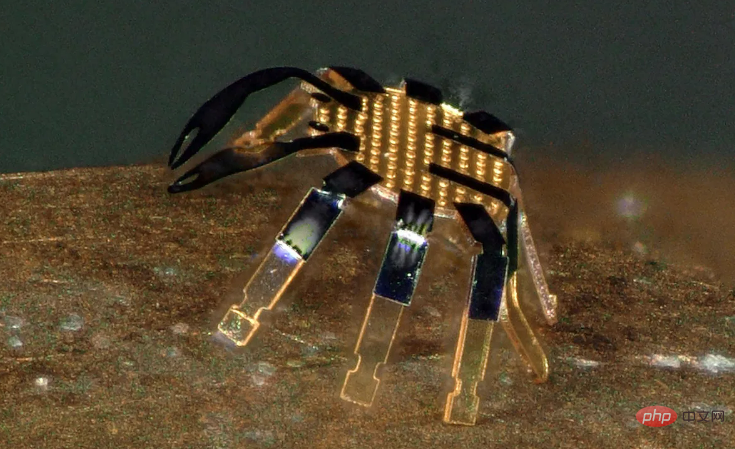 Technology peripherals
Technology peripherals
 AI
AI
 Can walk on the edge of a coin! The smallest crab robot on land is launched and could be used for minimally invasive surgeries in the future
Can walk on the edge of a coin! The smallest crab robot on land is launched and could be used for minimally invasive surgeries in the future
Can walk on the edge of a coin! The smallest crab robot on land is launched and could be used for minimally invasive surgeries in the future

This "sideways walking" micro-robot is so cute!
The May issue of Science Robotics published a study by Northwestern University. This study introduces A sub-millimeter level multi-material land robot was developed.
According to reports, this robot is inspired by a crab. Its miniature size and flexible pace allow this small robot to walk freely on the edge of a coin while being remotely controlled.
In the future, this robot can be used for confined space operations and even minimally invasive surgeries.

Paper link:
https://www.science.org/doi/10.1126/scirobotics.abn0602.
Inspired by the "Peeping Toe Crab", it is the smallest micro-robot on land
From the appearance, this robot has 8 legs, a pair of pincers, a round body and a crab Very similar, it is indeed inspired by a crab - the "Peeping Toe Crab"
John A. Rogers, the lead researcher of this study, said that their work complements other The work of scientists working on millimeter-scale robots, for example, is a worm-like structure that can move through a liquid medium with flagella.
But as far as he knows, their crab microrobot is the smallest land robot, only half a millimeter wide, that can walk on solid surfaces in the open air.

The robot is composed of three key materials: an electronic-grade polymer for the body and limbs; and shape memory alloy (SMA) that forms the "moving" parts. ;There is also a thin layer of glass that acts as an exoskeleton to increase the rigidity of the structure.
Rogers added that they are not limited by these specialty materials, however, his team is looking at ways to integrate semiconductor materials and other types of conductors.
Shape memory alloy (SMA) helps the "little crab" move
This tiny robot is able to move quickly due to the presence of shape memory alloy (SMA). This type of material undergoes a phase change at a certain temperature, causing a change in shape.
Rogers said: "So you create the material in an initial geometry, deform it, and then when you heat it, it goes back to the initial geometry... We use the shape change as some kind of mechanical actuator or The basis of some kind of muscle."

To get the memory metal to heat up, the researchers used a laser beam focused on the robot. "Whenever a laser beam illuminates the robot's shape memory alloy parts, it causes a phase change and corresponding motion," Rogers said. "When the laser beam is moved away, these parts are rapidly cooled and the limb It will return to the deformed geometry."
Therefore, laser spots scanning the robot's body can sequentially activate various joints to establish gait and direction of movement.
While this approach has its merits, Rogers wants to explore more options. "With lasers, you need some kind of optical access... (but) depending on where you want the robot to work, whether that's feasible or not," Rogers said.
Microrobotics Expert's Natural Philosophy
This is not the first time Rogers has referenced things in nature to create submillimeter-sized robots.
His lab has developed tiny structures that resemble worms and beetles, and even a winged microchip that moves passively through the air on the same principle that wind spreads seeds.
 In 2015, Rogers and his colleagues also published a paper on how to exploit the Japanese art of kirigami (such as that seen in pop-up books) They designed their robot based on the kirigami concept.
In 2015, Rogers and his colleagues also published a paper on how to exploit the Japanese art of kirigami (such as that seen in pop-up books) They designed their robot based on the kirigami concept.
They used high-fidelity, multilayer stacks of patterned materials supported by silicon wafers, but while these materials are useful for integrated circuits, they "are not good for robots," Rogers said, because they are flat. In order to bring them into the third dimension, studying the principles of Qi is a starting point.
As Rogers emphasized, their research is currently purely exploratory, trying to introduce some additional ideas into microrobotics engineering.
"We can move these robots and make them go in different directions, but they don't perform a specific task," he said.
For example, even though the crab robot has claws, these are only for visual purposes, they do not move or grasp objects. "Creating capabilities for mission execution will be the next step in research in this area," he said. Now, however, making multi-material 3D structures and using SMA for bidirectional actuation are two key parts of his team's contribution to wider research.
To explore further, he and his colleagues are considering how to increase the ability to grasp or manipulate objects at this scale and how to add microcircuitry, digital sensors and wireless communications to the robots. For example, communication between robots could allow them to work as a swarm. Another area for research is adding some kind of local power supply powered by photovoltaics, for example, to provide local heating via a microcontroller in a time-sequential manner to control movement.
In terms of potential applications, Rogers envisions microrobots being used for work in confined spaces, primarily for minimally invasive surgery, and to a lesser extent vehicles for making other micromachines. But he also advocates caution: "I don't want to overstate what we're doing. It's easy to fantasize about these robots going into the body and doing some powerful things medically. (But) that's where we want to be, and that's That’s what drives a lot of our work.”
Related coverage:
- https://spectrum.ieee.org/microrobots-walking.
- https://www.science.org/doi/10.1126/scirobotics.abn0602.
- https://www.nature.com/articles/s41586-021-03847-y.
- https://www.pnas.org/doi/full/10.1073/pnas.1515602112.
The above is the detailed content of Can walk on the edge of a coin! The smallest crab robot on land is launched and could be used for minimally invasive surgeries in the future. For more information, please follow other related articles on the PHP Chinese website!

Hot AI Tools

Undresser.AI Undress
AI-powered app for creating realistic nude photos

AI Clothes Remover
Online AI tool for removing clothes from photos.

Undress AI Tool
Undress images for free

Clothoff.io
AI clothes remover

AI Hentai Generator
Generate AI Hentai for free.

Hot Article

Hot Tools

Notepad++7.3.1
Easy-to-use and free code editor

SublimeText3 Chinese version
Chinese version, very easy to use

Zend Studio 13.0.1
Powerful PHP integrated development environment

Dreamweaver CS6
Visual web development tools

SublimeText3 Mac version
God-level code editing software (SublimeText3)

Hot Topics
 The second generation Ameca is here! He can communicate with the audience fluently, his facial expressions are more realistic, and he can speak dozens of languages.
Mar 04, 2024 am 09:10 AM
The second generation Ameca is here! He can communicate with the audience fluently, his facial expressions are more realistic, and he can speak dozens of languages.
Mar 04, 2024 am 09:10 AM
The humanoid robot Ameca has been upgraded to the second generation! Recently, at the World Mobile Communications Conference MWC2024, the world's most advanced robot Ameca appeared again. Around the venue, Ameca attracted a large number of spectators. With the blessing of GPT-4, Ameca can respond to various problems in real time. "Let's have a dance." When asked if she had emotions, Ameca responded with a series of facial expressions that looked very lifelike. Just a few days ago, EngineeredArts, the British robotics company behind Ameca, just demonstrated the team’s latest development results. In the video, the robot Ameca has visual capabilities and can see and describe the entire room and specific objects. The most amazing thing is that she can also
 How can AI make robots more autonomous and adaptable?
Jun 03, 2024 pm 07:18 PM
How can AI make robots more autonomous and adaptable?
Jun 03, 2024 pm 07:18 PM
In the field of industrial automation technology, there are two recent hot spots that are difficult to ignore: artificial intelligence (AI) and Nvidia. Don’t change the meaning of the original content, fine-tune the content, rewrite the content, don’t continue: “Not only that, the two are closely related, because Nvidia is expanding beyond just its original graphics processing units (GPUs). The technology extends to the field of digital twins and is closely connected to emerging AI technologies. "Recently, NVIDIA has reached cooperation with many industrial companies, including leading industrial automation companies such as Aveva, Rockwell Automation, Siemens and Schneider Electric, as well as Teradyne Robotics and its MiR and Universal Robots companies. Recently,Nvidiahascoll
 The first robot to autonomously complete human tasks appears, with five fingers that are flexible and fast, and large models support virtual space training
Mar 11, 2024 pm 12:10 PM
The first robot to autonomously complete human tasks appears, with five fingers that are flexible and fast, and large models support virtual space training
Mar 11, 2024 pm 12:10 PM
This week, FigureAI, a robotics company invested by OpenAI, Microsoft, Bezos, and Nvidia, announced that it has received nearly $700 million in financing and plans to develop a humanoid robot that can walk independently within the next year. And Tesla’s Optimus Prime has repeatedly received good news. No one doubts that this year will be the year when humanoid robots explode. SanctuaryAI, a Canadian-based robotics company, recently released a new humanoid robot, Phoenix. Officials claim that it can complete many tasks autonomously at the same speed as humans. Pheonix, the world's first robot that can autonomously complete tasks at human speeds, can gently grab, move and elegantly place each object to its left and right sides. It can autonomously identify objects
 After 2 months, the humanoid robot Walker S can fold clothes
Apr 03, 2024 am 08:01 AM
After 2 months, the humanoid robot Walker S can fold clothes
Apr 03, 2024 am 08:01 AM
Editor of Machine Power Report: Wu Xin The domestic version of the humanoid robot + large model team completed the operation task of complex flexible materials such as folding clothes for the first time. With the unveiling of Figure01, which integrates OpenAI's multi-modal large model, the related progress of domestic peers has been attracting attention. Just yesterday, UBTECH, China's "number one humanoid robot stock", released the first demo of the humanoid robot WalkerS that is deeply integrated with Baidu Wenxin's large model, showing some interesting new features. Now, WalkerS, blessed by Baidu Wenxin’s large model capabilities, looks like this. Like Figure01, WalkerS does not move around, but stands behind a desk to complete a series of tasks. It can follow human commands and fold clothes
 Ten humanoid robots shaping the future
Mar 22, 2024 pm 08:51 PM
Ten humanoid robots shaping the future
Mar 22, 2024 pm 08:51 PM
The following 10 humanoid robots are shaping our future: 1. ASIMO: Developed by Honda, ASIMO is one of the most well-known humanoid robots. Standing 4 feet tall and weighing 119 pounds, ASIMO is equipped with advanced sensors and artificial intelligence capabilities that allow it to navigate complex environments and interact with humans. ASIMO's versatility makes it suitable for a variety of tasks, from assisting people with disabilities to delivering presentations at events. 2. Pepper: Created by Softbank Robotics, Pepper aims to be a social companion for humans. With its expressive face and ability to recognize emotions, Pepper can participate in conversations, help in retail settings, and even provide educational support. Pepper's
 American university opens 'The Legend of Zelda: Tears of the Kingdom' engineering competition for students to build robots
Nov 23, 2023 pm 08:45 PM
American university opens 'The Legend of Zelda: Tears of the Kingdom' engineering competition for students to build robots
Nov 23, 2023 pm 08:45 PM
"The Legend of Zelda: Tears of the Kingdom" became the fastest-selling Nintendo game in history. Not only did Zonav Technology bring various "Zelda Creator" community content, but it also became the United States' A new engineering course at the University of Maryland (UMD). Rewrite: The Legend of Zelda: Tears of the Kingdom is one of Nintendo's fastest-selling games on record. Not only does Zonav Technology bring rich community content, it has also become part of the new engineering course at the University of Maryland. This fall, Associate Professor Ryan D. Sochol of the University of Maryland opened a course called "
 The humanoid robot can do magic, let the Spring Festival Gala program team find out more
Feb 04, 2024 am 09:03 AM
The humanoid robot can do magic, let the Spring Festival Gala program team find out more
Feb 04, 2024 am 09:03 AM
In the blink of an eye, robots have learned to do magic? It was seen that it first picked up the water spoon on the table and proved to the audience that there was nothing in it... Then it put the egg-like object in its hand, then put the water spoon back on the table and started to "cast a spell"... …Just when it picked up the water spoon again, a miracle happened. The egg that was originally put in disappeared, and the thing that jumped out turned into a basketball... Let’s look at the continuous actions again: △ This animation shows a set of actions at 2x speed, and it flows smoothly. Only by watching the video repeatedly at 0.5x speed can it be understood. Finally, I discovered the clues: if my hand speed were faster, I might be able to hide it from the enemy. Some netizens lamented that the robot’s magic skills were even higher than their own: Mag was the one who performed this magic for us.
 Cloud Whale Xiaoyao 001 sweeping and mopping robot has a 'brain'! | Experience
Apr 26, 2024 pm 04:22 PM
Cloud Whale Xiaoyao 001 sweeping and mopping robot has a 'brain'! | Experience
Apr 26, 2024 pm 04:22 PM
Sweeping and mopping robots are one of the most popular smart home appliances among consumers in recent years. The convenience of operation it brings, or even the need for no operation, allows lazy people to free their hands, allowing consumers to "liberate" from daily housework and spend more time on the things they like. Improved quality of life in disguised form. Riding on this craze, almost all home appliance brands on the market are making their own sweeping and mopping robots, making the entire sweeping and mopping robot market very lively. However, the rapid expansion of the market will inevitably bring about a hidden danger: many manufacturers will use the tactics of sea of machines to quickly occupy more market share, resulting in many new products without any upgrade points. It is also said that they are "matryoshka" models. Not an exaggeration. However, not all sweeping and mopping robots are





